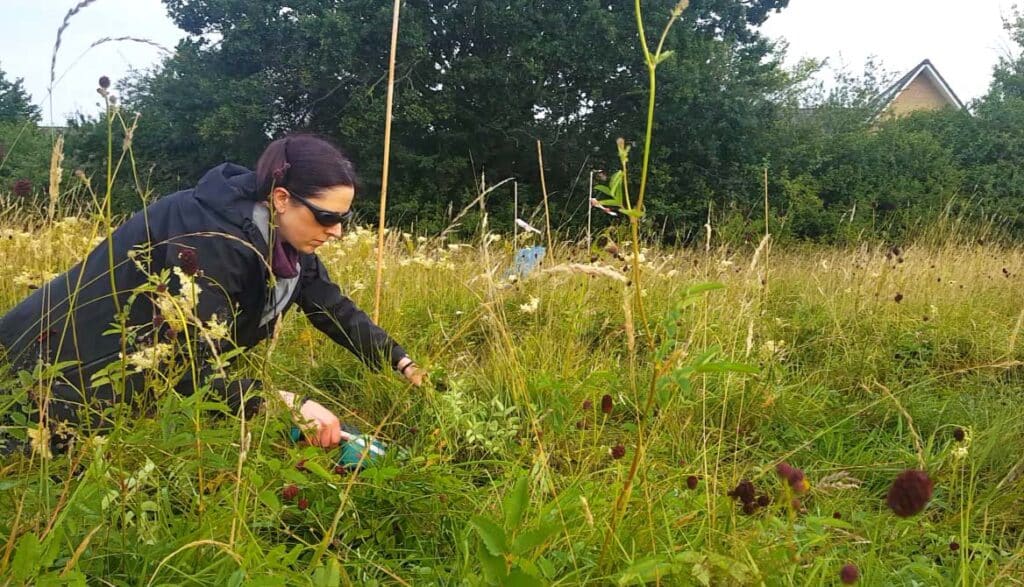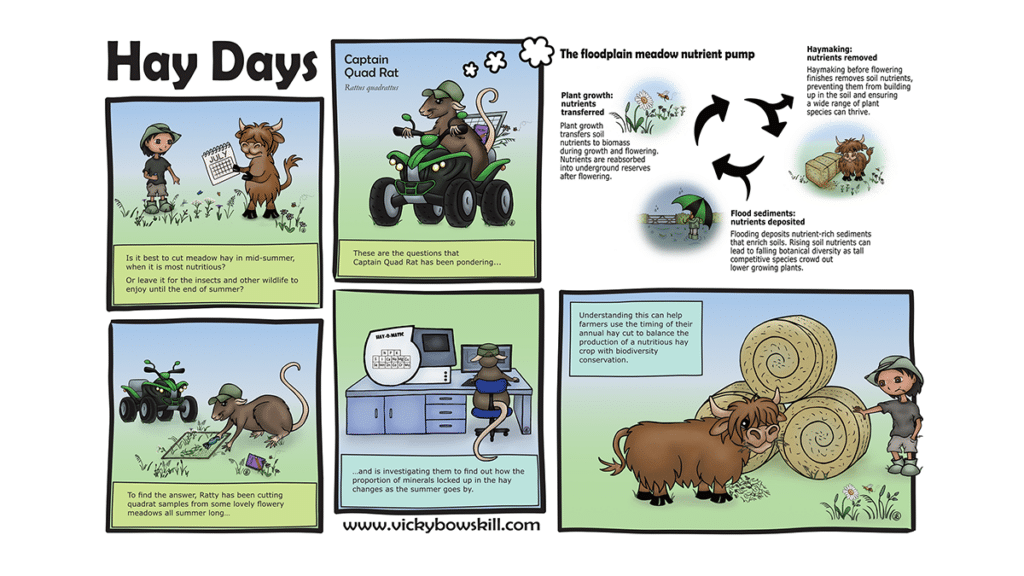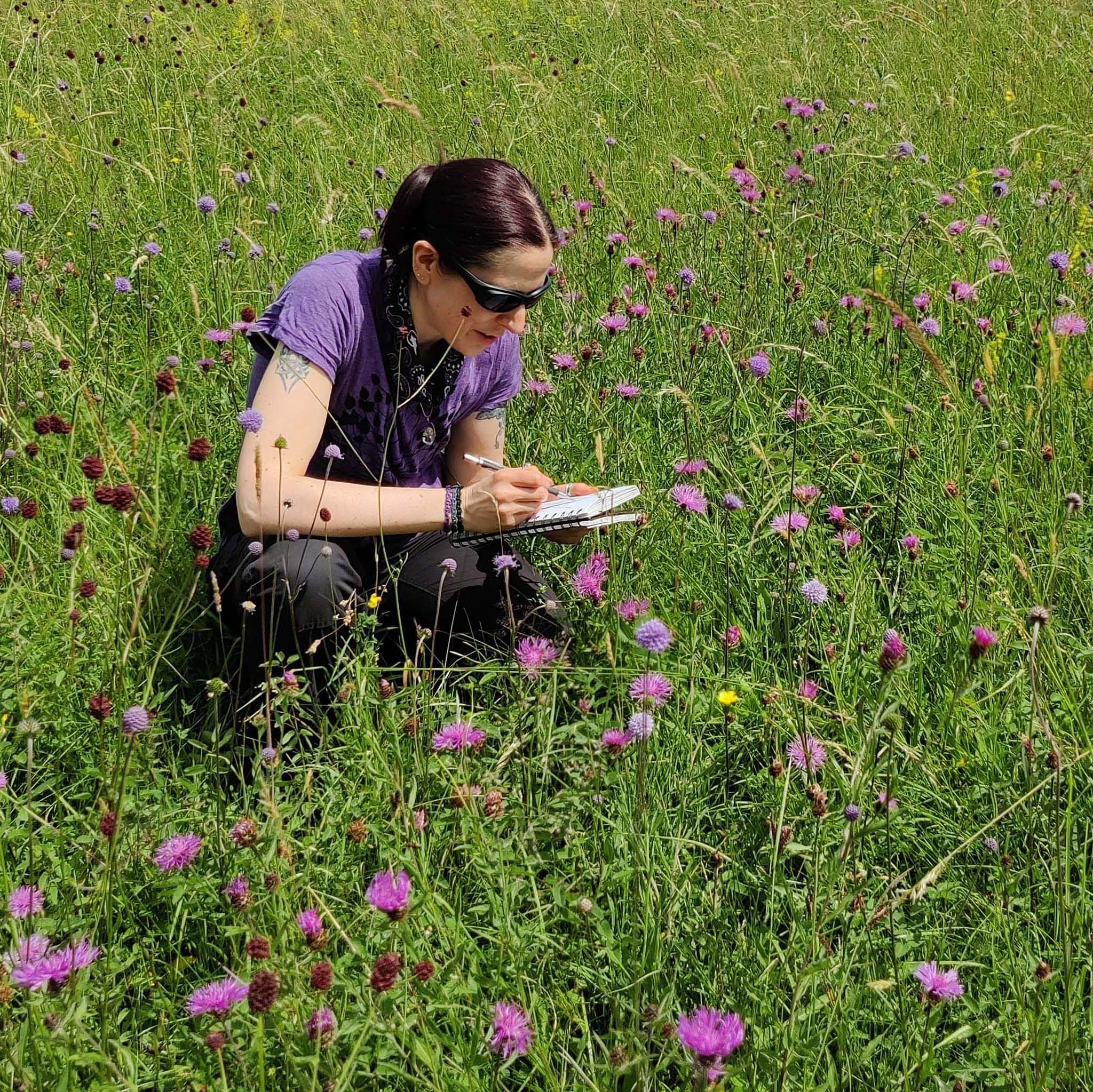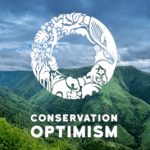Have you ever wondered how conservationists spend their days or what keeps them optimistic about the future of nature? Do they always spend their time in the distant wild, or might they be hidden all around us? Do their roles encompass aspects we never thought of?
“Meet The Optimists” is a monthly blog series by Conservation Optimism which introduces conservationists working in different fields and contexts to our readers. We discuss their journeys into conservation, typical daily activities and reasons for hope.
Read on for the inside story on different careers and fresh approaches to conservation!
In the October 2023 blog of Conservation Optimism’s “Meet The Optimists” series, Vicky Bowskill tells us the tale of a science communicator and a PhD student and how she balances these two aspects of her life as a conservationist!

Vicky Bowskill
“Hi! I’m Vicky Bowskill, an illustrator, storyteller and grassland ecologist with a passion for creative science communication. Currently a part-time PhD researcher at the Open University, I’m studying the sustainable management of our rare and beautiful floodplain meadows to find ways to balance nature-friendly farming and biodiversity conservation. This has involved doing field research to look at seasonal nutrient cycles and how this influences crop quality and biodiversity. An important complement to the fieldwork has been interviewing some of the fantastic farmers looking after our countryside to find out about the practicalities of managing these special meadows.
When not PhDing, I work as a freelance science communicator and illustrator, helping researchers and project managers increase engagement with wider audiences through inclusive and impactful visuals. I love telling stories, whether in words or pictures – and preferably both!”
Can you trace the origins of your interest in conservation and what led to your current work?
I’ve taken a long and winding route to get to where I am now. I was always a nature kid, usually found surrounded by leaves and mud whenever possible. As a small child I remember being totally fascinated by an orange-tip butterfly that my grandad found in a spiderweb and put in a matchbox for me. I carried this treasure everywhere and spent lots of time peering at the fine detail of its wings. The orange-tip is still my favourite species of butterfly.
My interest in nature was given purpose when I was about 8 or 9, and I found a dead mallard drake that had drowned after becoming entangled in plastic. It had happened only recently, and I was so struck by the connection between human behaviour (littering) and the demise of this beautiful duck – the shimmering green of its head feathers was astonishing! If I had been there just a bit earlier, perhaps I could have saved it. Taking the duck home, I insisted on giving it a proper burial. I understood then that humans had a destructive impact on nature, and I needed to help stop it from happening.
After school, I went on to study practical conservation, then art and design and eventually ended up working in countryside access, helping to create inclusive access to the countryside. Due to the difficulties arising from unrecognised neurodivergence that dogged my earlier education, it wasn’t until much later that I returned to education as a mature student to study environmental sciences part-time at the Open University. And, eventually, to the PhD that I have now almost finished. And it was only after I began my PhD that I realised I could combine my love of nature, science and art through creative science communication.
What does a typical day of work look like for you?
These days, I work mainly from home, but there is a lot of variety in what I do daily. I generally organise my work according to the type of energy I need to do it to make the best of my own daily energy cycles. For me, analytical work is best done with my morning brain; digging into bigger projects or creative work is good for an afternoon, and admin odds and ends can fit in at the end when I’m feeling less focused.
I always begin my day with a walk or workout as I think best on the move. When I’m back at my desk, I could be analysing data or working on my thesis in the morning. Later, I might be writing or editing blogs and working on website maintenance or social media content. Or I might be working on an illustration or animation project. At the end of the day, I deal with admin bits and organise my to-do list for the next day.
I often have meetings or seminars to attend, and these are usually online – though I do occasionally pop over to campus or have a field event to head out to.
I usually finish my day with another walk before dinner to process everything I’ve been doing. This is often when new ideas and solutions to problems I’ve been grappling with pop up, so I make notes as I walk so that I can start with those things the next day.
I’ll often continue to work on illustrations in the evenings but have a general rule about not working evenings and weekends, so I don’t rely on needing to work at those times.

Sampling hay meadow vegetation for her PhD research. Photo courtesy Vicky Bowskill
What is your favourite and least favourite aspect about your role?
Many environmental topics are based on some loss, inequality or other negative story. It can be tough learning about the problem aspects of the projects I’m working on. It takes effort to maintain a solution-focus.
But I love the range of projects I get to delve into alongside my own research. Being able to work with other researchers and project leaders to find out about what they are doing and translate it into fun visuals to promote their work is tremendously satisfying. I love that I get to enjoy doing this and that it helps to engage wider audiences with important and fascinating topics. I also love the freedom that I have; to work in a way that really suits my neurodivergent style so I can bring my best self to my work.
As a conservationist, what makes you hopeful about the future?
The fact that environmental issues are now such a common topic in conversations and the news. This can look like more scary facts to be daunted by first thing in the morning when you turn on the news. But, increasingly, a wealth of talented storytellers are finally translating this into impactful stories that can truly motivate action.
Of course, there is still debate and deniers, and not nearly enough action from governments. But ordinary people are now increasingly aware of the problems we face and how they can choose differently. Young people, in particular, are now making different choices based on environmental concerns. And information about what each of us can do is now so easy to access that making better choices is possible for everyone.
Yes, things are bad. The big changes we still need to achieve at a global scale must involve significant governmental action. But big changes are made up of many small changes, and organisations like Conservation Optimism make it possible for people to see how their actions can add to the collective movement that is gathering momentum. Through good quality communication and collaboration, there is still time to build a brighter future – and even have fun doing it!

At her home desk working on a digital illustration project. Photo Courtesy Vicky Bowskill
What helps you stay positive day-to-day?
Historically, this is something I have really struggled with. I’ve grappled with what we now call eco-anxiety for decades since learning about environmental problems and watching the spectacular lack of popular interest or concern whilst the planet has been slowly dying around us. However, I have found ways to genuinely feel much more positive about the future.
I watch my media diet to make sure I’m getting a balance. I limit my exposure to negative news, listening to just enough to know what is going on in the world. But then I switch to positive news sources and find out about all the amazing work passionate people are doing to make things better. And sometimes even no news at all! I also limit my time on social media and make sure I’m curating my feed so I don’t get sucked into doom-scrolling.
Of course, I still get all the feelings about the never-ending negative news cycle. But by going out of my way to balance this with positive news stories, it helps me to see how my own efforts are combining with the work of others to take us in a better direction. It has taken billions of us to get into our current situation, and we need to work together to turn things around. But we can do it!
I also make sure I look after myself well so I have the energy to keep doing what I do. I have an excellent coaching group of environmentally passionate people to help keep me on track through motivation and cheerleading, as well as talking through the blocks and difficult things. Good self-care is an essential part of being an effective changemaker.
Could you share a story about a formative moment in your conservation career?
I’ve always been interested in both art and the environment, but I felt I needed to choose one or the other for my career; environment won, and art was relegated to a hobby. It was only after starting my PhD and sharing some of the SciArt I had created to communicate my own research that I realised I could combine these two passions. Who knew!? People started to ask me if I took commissions, and I was stunned at first that people were so interested in my creative work.
With limited energy, I eventually went part-time on my research, so I had the time and energy to take on commissions – and I’ve never looked back! I’ve discovered a thriving community of science communicators across the globe, and I love the freedom and variety that freelance work gives me. And I love that I can unleash my creative side and still be doing work that is contributing to societal change and environmental improvements. I’m just one person, but I found a way to use my own unique flavour to be a part of the solution. I’d love to go back and tell young me that this was possible, but I have learned from every step I took along the way.


Captain Quad Rat and Professor Lab Rat were created during lockdown, and some of the first illustrations Vicky used to share her research.
Any advice for someone interested in pursuing your field of work?
One thing we’ve learned from years of bashing people with facts and seeing no change in the world is that we need more storytellers! If you are environmentally passionate and you have a knack for telling stories in any medium, then you can make a real difference in the world by combining these skills. Science communication has been a skills-shortage area but is now a fast-growing field, so come and join in!
Above all, my advice would be to take excellent care of yourself, stay curious and creative, be tenacious and find your tribe. Bring your whole self to your work and use that authenticity to build genuine connections with audiences to showcase the causes you are working for.
Follow Vicky’s work on her Instagram!


